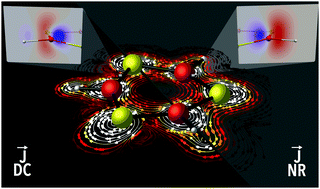Relativistic effects on the aromaticity of E3M3H3 (E = C–Pb; M = N–Bi) benzene analogues†
Abstract
The relativistic effects on the aromaticity of a set of benzene analogues, E3M3H3 (E = C–Pb; M = N–Bi) heterocycles, using magnetically induced current density (MICD) and the NICSzz component of the conventional nucleus independent chemical shift (NICS), is hereby examined. The relativistic effects were evaluated by means of four-component relativistic MICD, and two-component NMR relativistic shielding tensor methods. MICD and NICS were also computed in a non-relativistic fashion, to assess the influence of scalar-relativistic and spin–orbit effects. Most of the studied compounds exhibit a net diatropic ring current (aromatic), excluding the nitrogen-containing compounds which are non-aromatic (except for C3N3H3), in agreement with their higher E–N electronegativity difference. Only in the case of bismuth compounds, E3Bi3H3, aromaticity is substantially decreased when relativistic effects are included (mainly due to the spin–orbit contribution). The larger the mass of the system, the larger the magnitude of this change, in line with the expected relativistic effects for heavier elements. The analysis based on the NICSzz computations agrees with that of the MICD, thus supporting both the magnetic behavior and the aromatic character of these compounds.

- This article is part of the themed collection: 2020 PCCP HOT Articles


 Please wait while we load your content...
Please wait while we load your content...